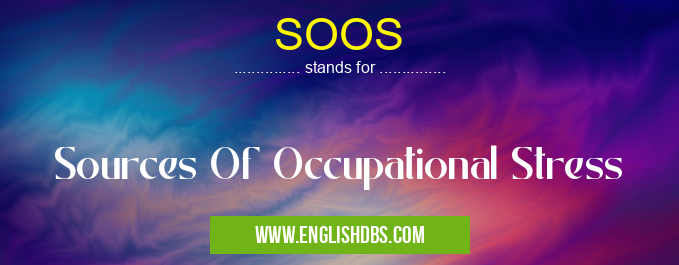What does SOOS mean in UNCLASSIFIED
SOOS stands for Sources Of Occupational Stress. Occupational stress refers to the harmful physical and emotional responses that can occur when the demands of a job exceed the resources and capabilities of the worker. SOOS can be categorized into various factors that contribute to stress in the workplace. Understanding these sources is crucial for employers and employees to mitigate their negative impact and promote a healthy work environment.

SOOS meaning in Unclassified in Miscellaneous
SOOS mostly used in an acronym Unclassified in Category Miscellaneous that means Sources Of Occupational Stress
Shorthand: SOOS,
Full Form: Sources Of Occupational Stress
For more information of "Sources Of Occupational Stress", see the section below.
Sources of Occupational Stress
1. Work Overload:
- Excessive workload, unrealistic deadlines, and time pressure can lead to feelings of anxiety, exhaustion, and reduced productivity.
2. Role Conflict and Ambiguity:
- Unclear job roles, conflicting demands, and lack of autonomy can create confusion and uncertainty, leading to stress.
3. Job Insecurity:
- Fear of job loss, downsizing, or layoffs can trigger anxiety and stress, affecting employee morale and performance.
4. Interpersonal Relationships:
- Negative interactions with colleagues, supervisors, or clients can create a stressful and hostile work environment.
5. Physical Environment:
- Uncomfortable working conditions, such as poor lighting, noise, or extreme temperatures, can contribute to physical and mental strain.
6. Technological Change:
- Rapid technological advancements and the need to adapt to new software or equipment can cause stress for employees who may feel overwhelmed or inadequate.
7. Organizational Culture:
- A toxic organizational culture characterized by lack of support, high competition, or unrealistic expectations can foster stress and burnout.
Essential Questions and Answers on Sources Of Occupational Stress in "MISCELLANEOUS»UNFILED"
What are the main sources of occupational stress (SOOS)?
The primary sources of occupational stress (SOOS) can be categorized as follows:
- Job demands: Excessive workload, time pressure, conflicting demands, role ambiguity, and role overload.
How does job insecurity contribute to occupational stress?
Job insecurity, characterized by uncertainty about job stability, can lead to:
- Anxiety and worry about job loss.
- Reduced job satisfaction and motivation.
- Increased physical and mental health symptoms.
What is the impact of workplace culture on occupational stress?
A negative workplace culture can contribute to stress by fostering:
- Lack of support and recognition.
- Unfair treatment and discrimination.
- Poor communication and lack of transparency.
How can relationships with colleagues affect occupational stress?
Conflict or tension with colleagues can lead to:
- Reduced job satisfaction and productivity.
- Emotional exhaustion and burnout.
- Increased risk of mental health issues.
What are the physical consequences of occupational stress?
Prolonged occupational stress can manifest physically as:
- Increased blood pressure and heart rate.
- Headaches and muscle tension.
- Fatigue and insomnia.
- Gastrointestinal problems.
Final Words: Identifying and addressing SOOS is essential for organizations to create a workplace that promotes employee well-being and productivity. By implementing measures to reduce workload, improve communication, provide job security, foster positive relationships, enhance the physical environment, support technological transitions, and cultivate a supportive organizational culture, employers can mitigate occupational stress and create a healthier and more sustainable work environment for their employees.
